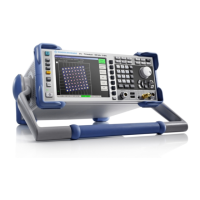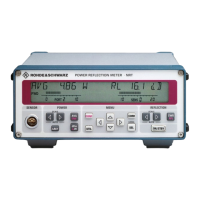Setting the Amplitude Parameters R&S FSH
1309.6275.12 4.6 E-2
Setting the Amplitude Parameters
All R&S FSH settings referred to the level display are made with the AMPT key.
The reference level (REF) is the level represented by the uppermost grid line in the measurement
diagram. The input signal gain up to the display stage is set with the reference level. If the reference
level is low, the gain is high, which means that even weak signals are clearly displayed. If the input
signals are strong, a high reference level must be set to prevent the analyzer signal path from being
overdriven and to keep the signal display within the display range. When displaying the spectrum of a
composite signal, the reference level should be at least high enough to ensure that all the signals are
within the measurement diagram.
The RF attenuation setting at the input of the R&S FSH is directly coupled to the reference level. If the
reference level is high, RF attenuation is switched on in steps of 10 dB according to the following table
so that the input mixer always remains in the linear range.
The R&S FSH has two different modes for the attenuation setting. The modes are selected using the
RF ATT / AMP / IMP softkey. In Auto Low Distortion mode, the R&S FSH sets the RF attenuation 10 dB
higher in line with the table, making the stress of the input mixer 10 dB less at the specified reference
level. If the spectrum is densely occupied with signals, as occurs in a television cable network, the input
mixer reduces the R&S FSH's inherent spurious products. However, the inherent noise display of the
R&S FSH increases due to the increased attenuation in front of the input mixer.
In Auto Low Noise mode, the R&S FSH sets the RF attenuation 10 dB lower. This increases the
sensitivity of the R&S FSH, which means that the inherent noise display decreases due to the lower
attenuation in front of the input mixer.
Preamplifier
OFF
Preamplifier
ON
Reference Level
RF attenuation RF attenuation
Low Noise Low Distortion Low Noise Low Distortion
-30 dBm
0 dB 0 dB 0 dB 0 dB
-29 bis -25 dBm 0 dB 0 dB 0 dB 5 dB
-24 bis -20 dBm 0 dB 0 dB 0 dB 10 dB
-19 bis -15 dBm 0 dB 5 dB 5 dB 15 dB
-14 bis -10 dBm 0 dB 10 dB 10 dB 20 dB
-9 bis -5 dBm 5 dB 15 dB 15 dB 25 dB
-4 bis 0 dBm 10 dB 20 dB 20 dB 30 dB
1 bis 5 dBm 15 dB 25 dB 25 dB 35 dB
6 bis 10 dBm 20 dB 30 dB 30 dB 40 dB
11 bis 15 dBm 25 dB 35 dB 35 dB 40 dB
16 bis 20 dBm 30 dB 40 dB 40 dB 40 dB
21 bis 25 dBm 35 dB 40 dB 40 dB 40 dB
26 bis 30 dBm 40 dB 40 dB 40 dB 40 dB
The status of the RF attenuation and the preamplifier can be queried in the Status menu (press the
STATUS key).

